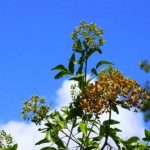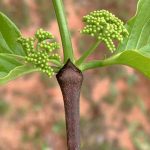TREE LIFE
December 1997
MASHONALAND CALENDAR
Tuesday 2nd December. Botanic Garden Walk. The fascinating fig saga continues this month. A list will be available. We will meet Tom in the car park at 4.45 for 5.00 p.m. and there will be a guard for the cars.
Sunday 7th December. James and Anne Sinclair of Serui Source Farm in the Norton area are kindly hosting our Christmas outing. We will meet in the garden of the homestead for tea and then move off in convoy to a special site where Phil Haxen will teach and tease as he leads the group in a game of ‘Tree Bingo’.
Tea will be provided but please bring a cake or a few sandwiches to share, as well as your chair, and of course your lunch for later.
Saturday 3rd January. Mark’s subject on this walk will be about ferns. Domboshawa is rich in ferns so if you have a fern book bring it and learn more about them.
Tuesday 6th January. Botanic Garden Walk
January 23rd to 26th. A wonderful time of year to spend a few days botanising in Nyanga. We have arranged accommodation in our favourite cottages at Ezulweni. The cottages, situated at the base of Rukotso Mountain are fully equipped; we need only bring our food and drink. This is for a limited number of people so first come first served. The cost will be $250 per person for the whole weekend (3 nights). Please contact Maureen Silva-Jones to reserve your place.
Saturday 31st January. Mark’s Botanic Walk
MATABELELAND CALENDAR
Sunday 7th December. Half-day visit to Mazwi Nature Reserve. Remember to bring your entrance fee. (±$20?). Meet at Girls’ college at 8-8.30.
January 1st or 4th. New Year social please make contact with one of your committee members for details closer to the time.
Wednesday 7th January. On the first Wednesday of each of the next 6 months one episode of the wonderful video “The Private Life of Plants” will be shown at Girls’ College at 7.30 for 8 p.m. The episodes have enchanting titles such as Travelling; Growing; Flowering; Social Struggle; Living together; and Surviving.
January Visit to Sentinel Ranch near Beitbridge – a long weekend or longer. Tentative dates are around January 17th-20th or 24th-27th. Please make contact with Jonathan Timberlake who is arranging this trip.
Sunday February 1st. Visit to Chipangali where we have been invited to assist in the development of an indigenous tree wood lot.
Ivordale Farm, Enterprise, 19 October 1997.
Happily, although mid-October, the day was not unduly hot. Over thirty members led by Phil Haxen set off up the gradually sloping granite outcrop. Being on shallow rocky soil, the emergence of new leaf was a bit retarded, but the early species had sufficient new leaf to assist in identification, whilst in the others still devoid of leaf, identification was by characteristics of form, shape, and bark.
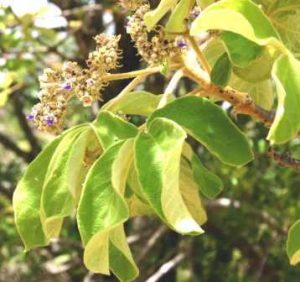
Vitex payos. Photo: Rob Burrett. Source: Flora of Zimbabwe
The ‘zigzag’ Euphorbia matabelensis with latex and three-lobed fruit, was much in evidence. Commiphora mossambicensis was plentiful showing the characteristic ‘apricot-like leaves’ and the rippled bark effect where spurs came off the main limbs. Then came Vitex payos, the ‘Chocolate Berry’ with deeply and vertically striated bark and palmately compound leaves. Strychnos spp. was common with its three-veined leaves, probably Strychnos innocua with light coloured and sometimes flaky bark. Both Erythrina abyssinica and Erythrina latissima were seen, the latter with much larger and rounder leaves and larger lucky bean seeds.
A fine specimen of Sterculia quinqueloba with five-lobed leaves attracted attention, and we learnt that the genus was named after the Roman God of ‘privies and manuring’, Sterculius, because some species smell a bit! Further on, the regular twist to the leaf apex assisted in identifying Combretum apiculatum which was common in this relatively dry habitat. Cussonia arborea, one of the ‘cabbage’ trees with five-lobed compound leaves and Pseudolachnostylis maprouneifolia, the Duiker berry were both seen. The latter, Phil explained, has the longest name on the Mashonaland Field Card, the name deriving from a resemblance to Lachnostylis, a tree of the Cape Province. The leaves are very like those of Maprounea africana, another Euphorbiaceous species, so hence the specific name. It all helps one to understand and hopefully remember! Anyway, Duiker relish the fruit, in fact all ungulates do so, which is acknowledged in the common name as well as the vernacular name, Mudyamhembwe. In South Africa the name is Kudu berry (has the Duiker been exterminated there?). It is a pretty tree, the more so when in autumn foliage.
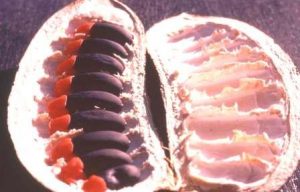
Afzelia quanzensis. Photo: Rawdon Goodier. Source: Flora of Zimbabwe
Several specimens of Pod Mahogany, Afzelia quanzensis, were present and Phil pointed out the yellow border to the margins of the leaflets which is diagnostic. Nearby was Julbernardia globiflora, and using a hand lens, we were able to see the white rim to the leaflets as white bristles fringing the leaflet margin. The latter genus was named after M. Jules Bernard – an interesting anecdote from John Cottrill. The derivation of scientific names is of interest – Bob Drummond’s book entitled Common Trees of the Central Watershed Woodlands of Zimbabwe is very helpful in this respect and no member should be without a copy.
The ‘ball and claw’ shaped terminal bud of Zanha africana was just visible at this early stage of leaf emergence, while the red coloration of the underbark when newly sloughed, was clearly visible and helpfully diagnostic. The specimen of Ozoroa insignis available to us was struggling for existence on the poor rocky and sandy soil, but evidently, in more favourable habitats, it grows into a majestic tree. Hence its generic name derived from the Ethiopian word for queen, ozora. Sadly, the tree is abused locally, the bark supposedly having aphrodisiac properties. Still leafless was Lannea discolor, but recognisable by the ‘dead man’s finger’ leaf buds about to burst and the texture of the bark, described by Drummond as ‘pale grey, irregularly fissured’.
Pavetta schumanniana, confirmed as poisonous to cattle, was seen to have black spots on the leaf when held up to the light. The quilted appearance of these hairy leaves is evidently to conserve moisture.
Pterocarpus angolensis, newly in leaf, was not uncommon but weakly grown on the shallow rocky soil. On deeper soil this tree yields the very fine furniture wood, Mukwa (Kiaat in S.A.), so widely exploited. It has the feature of exuding a blood-like sap when the bark is slashed, hence the vernacular name Mubvamaropa. Unfortunately, this phenomenon is common as the tree is widely used for muti purposes. The deeply serrated leaf margin and midrib raised on both upper and lower surfaces helped us identify Ochna puberula.
Returning to the car park area, we skirted around the foot of the outcrop where the soil was much deeper and subject to run-off from the sloping rock above. Tree specimens were much more strongly grown under the favourable conditions. Fine examples of Dalbergia nitidula, well leafed but not yet in flower were present. This species has a very attractive purple-red heartwood, different from the ebony black colour of its relative Dalbergia melanoxylon, both of which are used for carving. A splendid Pod Mahogany, Afzelia quanzensis, was in flower here and we were able to examine the single pink petal and smell the sweet nectar easily as the adjacent sloping rock slab allowed a close-up ‘bee-eye’ view. Kirkia acuminata was common and newly in leaf while the genus Ficus was represented by two species, Ficus thonningii, the notorious Strangler Fig, and Ficus glumosa, the Rock Splitting Fig.
Nearer the parking area one observant member pointed out three heavily weathered grinding holes in the granite, explaining that gold bearing ore was ground in these before panning it for the precious metal. Recovered gold was commonly stored in porcupine quills and, together with ivory, was the basis of the early trade in these regions with Arab, Portuguese and subsequent visitors.
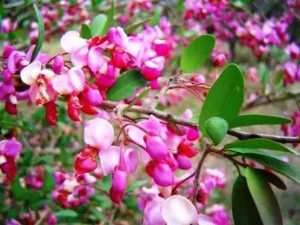
Securidaca longipedunculata. Photo: Bart Wursten. Source: Flora of Zimbabwe
The afternoon session began with a fine specimen of the Violet Tree, Securidaca longipedunculata, in full flower, at eye level, thankfully. Just think how frustrating it would be if the flowers were out of reach! This tree, happily, was not damaged, since its roots are also commonly preyed upon for muti. The roots contain methyl salicylate and when fresh, smell strongly of wintergreen. We were now in semi-vlei land with strongly grown thatching grass subject to fierce bushfires at times. The species in this vicinity were fire proof generally, exemplified by Terminalia sericea, Ziziphus mucronata, and Flacourtia indica. Well grown Parinari curatellifolia were present. This species some¬times gives off an unpleasant odour and is pollinated by a specific butterfly, although bees and flies were observed in attendance. The wood is evidently borer proof, but is seldom sawn due to the abrasive silica content and the fact that the tree produces a not unpleasant fruit. Also present were Syzygium guineense and the prostrate Syzygium huillense, with its underground contorted stem, well protected from fire and sometimes collected for ornamental purposes. The yellow flowers of Senna singueana were pretty, and the ‘bee sting’ like stipule between the terminal leaflets was visible.
The diehards then climbed part of a neighbouring granite hill with similar, but better grown vegetation than that seen earlier. The Euphorbia matabelensis were now handsome well grown specimens, presumably reflecting better soil between the granite slabs.
Pericopsis angolensis, Muwanga in Shona, was identified, not huge but fairly well grown. The wood of this tree is so durable that fencing posts made of it over fifty years ago are still standing as strong as ever to this day. Its future preservation seems assured because few axes, or the men that wield them, are strong enough to deal with the hard heartwood. In fields, too, it is mostly spared since the clear trunk and high foliage interfere little with crops underneath.
Among the ‘resurrection’ plants, green from rain the previous week, large Combretum zeyheri seed¬pods were seen and eventually the tree was spotted. Also visible were several small Elephantorrhiza goetzei trees with golden flower spikes. This tree derives its name from the ‘elephant’ sized roots below ground level. An interesting and informative outing well led by Phil whose perception in matters arboreal was as captivating as ever.
Thank you to the organisers and to the owners of Ivordale, Mr. and Mrs. Pascoe.
-John and Wendy Wilson.
BOTANIC GARDEN WALK: 4 NOVEMBER 1997
Part 2 of figs and a record number of people (c.25) were present. Because many people had not been there the previous month, some time was spent in revision.
Before Tom arrived, we had looked at Ficus sur and had been a bit put off by the figs extending onto quite small branches among the leaves, rather than just occurring on branches off the older wood. However, Tom confirmed it was Ficus sur. This is of course a familiar woodland species, often occurring also at forest edges.
By the lake grows Ficus capreifolia with its remarkable sandpaper leaves. It is a species of riverbanks and sandy riverbeds at medium and low altitudes. It can sucker rapidly and often extends by that method, producing a sprawling thicket of shrubby stems rather than a proper tree.
Whereas Ficus capreifolia is quite widespread in Zimbabwe, the other fig with exceptionally rough leaves, Ficus exasperata is much rarer, just extending into Zimbabwe at low altitudes in the Rusitu area of the E. Districts. Tom has a fine specimen in the forest section with a pale grey very smooth trunk. Tom remarked that the sap of Ficus exasperata is often clear, unlike most of our figs.
On to Ficus lutea (formerly Ficus vogelii), which has big round leathery leaves. It is another E. Districts species occurring in Chirinda forest and in various evergreen forest patches in the Chipinge area. Overall, not a common species.
Finally, we visited the nursery area to see a young Ficus bubu. Tom mentioned that this is the rarest species of fig in Zimbabwe and occurs in low altitude rainforest in the E. Districts.
Apart from figs, the remarkable sight of Cladostemon kirkii in full, pale yellow flower caught our attention.
Once again a very informative and interesting evening.
-Mark Hyde
This snippet is reprinted to correct the error that crept into the article last month.
Some time back an extract from the publication Beyond Supernature, by Lyall Watson, appeared in Tree Life. This extract gave an account of how southern African bushveld trees respond rapidly to heavy browsing pressure by producing extra tannins in their foliage as a defence mechanism. The tannins not only make the browse temporarily unpalatable, but also can even make it lethal. A bizarre twist to this research finding was the discovery that untouched trees close by also increase their tannin content within a very short time, apparently in sympathy with their damaged neighbours.
An even more bizarre discovery was reported in the National Geographic magazine of December 1989. Scientists have found that some plants emit ultrasonic acoustic emissions (ultrasonic chirps) when they are affected by drought stress, and the chirps increase as stress intensifies. Further experimental probing showed that bark beetles evidently recognize the distress signals and home in on the affected plants, while tending to leave “chirpless” plants alone.
–Lyn Mullin.
GWAAI RIVER VALLEY WEEKEND
A group of a dozen ‘tree people’ (plus two children) spent the weekend from 31 October to 2 November at the Gwaai Valley Safari Camp that overlooks the Gwayi River Valley. We were anxious to see the area that will eventually be flooded by the Gwayi-Shangani Dam, which may become the major source of water for a thirsty Bulawayo.
Some members made reservations for camping sites using their own equipment. Others rented a tent and bed and the majority opted for the ‘luxury’ of a self-catering lodge. Most brought their own food that somehow got prepared in a very small, poorly equipped kitchen with a wood stove. These were the self-catering facilities, it turned out. Two bathrooms to serve the whole group also seemed a bit unusual for operation advertising for international visitors. However, we grumbled a bit, did our best to keep the mopane flies at bay and took our tree walks early and late in the day to avoid heat and humidity that went well into the 30’s.
Saturday morning our walk was in the immediate area around the campsite. Tom and Mary Raub who have their own safari camp in the area joined us for the day. We mentioned to Jonathan that it seemed strange how straggling and leafless the trees were when we had seen the forests along the main road looking green and lush. His theory was that the campsite was in a ‘contact zone’ that had been disturbed, perhaps cleared and was only beginning to recover. As we walked he noted that many of the trees along the edge of the contact zone were Commiphora, although he also pointed out that there were Kirkia acuminata, Commiphora mossambicensis and Xeroderris stuhlmannii in the mix – all transitional species. However, the dominant species as the contact zone ended was Baikiaea plurijuga, growing in deep Kalahari sand on the escarpment crest.
Highlights of the morning walk were Afzelia quanzensis in very fresh new leaf prompting your chairman to think that it was an Albizia antunesiana until Jonathan spied the fallen flowers and a seedpod was seen. Albizia brevifolia, which was in flower and had even fewer and smaller leaves than normal.
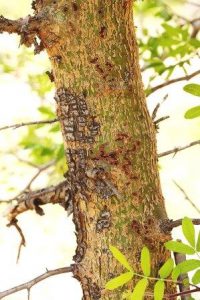
Commiphora ugogensis. Photo: Bart Wursten. Source: Flora of Zimbabwe
Commiphora ugogensis with its very knobby and spine covered brownish stem. Some disagreement ensued over Pteleopsis anisoptera, which was plentiful. One or two Lonchocarpus eriocalyx subsp. wankieensis were seen as well as some Lonchocarpus nelsii, and Ziziphus abyssinica. On the rocky areas a surprising number of Margaritaria discoidea were seen. Acacia eriocarpa with its very fuzzy leaves was a not often seen species. Maerua edulis (Courbonia glauca) which does really have delicious edible fruits, Haplocoelum foliolosum, Boscia mossambicensis (which has sweet purple fruits) and Cissus cactiformis were some more uncommon finds.
Lunch was mostly liquid as everyone dealt with symptoms of dehydration from the intense heat and humidity. A long rest period was the order of the day until about 3:30 p.m. when a smaller group of enthusiasts drove down the escarpment to the Gwayi River to look at the trees there.
The afternoon drive yielded a number of species that were not seen in the morning. The most exciting was probably a patch of big bushy individuals of Strophanthus nicholsonii which were in full flower in the vicinity of some very large specimens of Commiphora mollis which had buttressed on fluted trunks like Commiphora karibensis. A few Pterocarpus lucens were just coming into flower. Balanites aegyptiaca was just starting to flower and Combretum psidioides was in new fruit. Acacia polyacantha presented itself with some very large specimens.
It was sunset when we all gathered again for a braai. The walk along the river had been so successful that a plan was made for another walk on Sunday morning along the Shangani River in the area near where it converges with the Gwayi, the site of the new dam.
The Sunday morning walks took place in three separate groups, one or two of which made it to the Shangani. Your chairman made his own trip in the company of Tom Raub to Hwange in search of seeds of Stereospermum kunthianum.
An exciting find by Bernard Beekes at Mr. Benny’s dam was a specimen of Ficus sansibarica, which was doing its best to strangle a very large specimen of Xeroderris stuhlmannii.
The major excitement for Saturday evening was running out of water and having the toilet tanks filled with very hot water from a wood-fired steel drum as the source vanished. Relief for the situation arrived at dawn, but the group by this time was not feeling too charitable toward the management of the safari operation. We have no plans to return soon.
However, the Gwayi-Shangani area is most interesting, challenging us physically and in identifying new tree species. The trees and countryside were well worth the trip.
-Helen Hall.
LEAFY MINEFIELD SELF DEFENCE. Fungal booby traps protect trees from insect damage.
Botanists have recently been surprised and puzzled to find that many healthy trees contain endophytic fungi within their tissues. The fungi are eerily inactive, though they do appear to obtain nutrients from the tree, and cause no symptoms, and so their role has been something of a mystery. New research now shows that some of these fungi can operate as booby traps, helping the tree fend off attack by insects (German Research, vol.1/96).
Leo Pehl and Heinz Butin of the Federal Biological Research Centre for Agriculture and Forestry, Brunswick, studied oak and lime leaves that had been attacked by gall midges – small flies whose larvae produce galls on buds, leaves and stems. They noticed that many of the galls had died and were surrounded by a limited area of active fungus. This fungus was not some new invader, but an endophyte that had sprung into life around the gall.
Endophytic fungi, it seems, are a vital part of the tree’s defences. Though initially quiescent, they explode into action when gall midges attack, killing leaf tissue and preventing the midges from obtaining the food they need to survive. Because the unsuspecting insects trigger the deadly reaction themselves – when they suck at the leaves or lay their eggs – the researchers liken the process to stepping on a land mine.
Tree and fungus both seem to benefit from this arrangement. The tree is better defended than it would otherwise be and the fungus gets a chance to draw nutrients from the tree and complete its life cycle.
GALL GOBBETS
? A gall is the growth reaction of a plant host to a parasitic attack by a bacterium, fungus, eelworm, mite or insect. It develops either by an abnormal increase in the number of plant cells or by the cells becoming abnormally enlarged.
? Black blotches on sycamore leaves caused by the fungus Rhytisma acerinum and mines burrowed to the leaves by insect larvae are not galls because the role of the plant is passive.
? Most gall causers are host-specific – for example, gall wasps tend to be confined to oaks, whereas sawflies prefer willows.
-Clare Putnam
Acknowledged with thanks to author and BBC Wildlife October 1996.
ANDY MACNAUGHTAN CHAIRMAN


